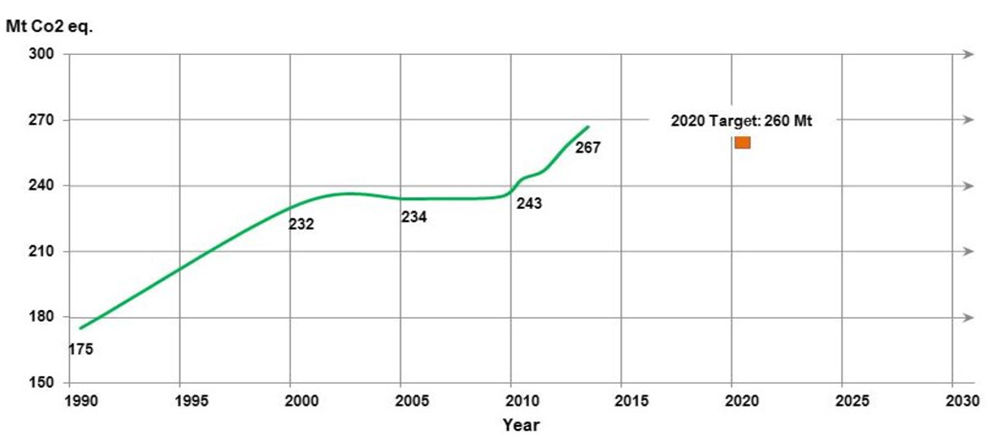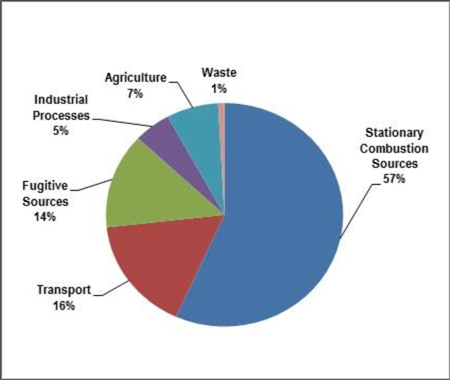Alberta: Environment profile
Note
This information was current as of November 2015.

Alberta (AB) in brief
- Premier:
- Hon. Rachel Notley (New Democratic Party)
- Population:
- 4,196,500 (2015)
- Total area:
-
661,848 km
2
- Land:
- 642,317 km 2
- Freshwater:
- 19,531 km 2
- Real GDP (gross domestic product) 2013:
- $303 billion (in 2007 dollars)
- Contribution to real Canadian GDP 2013:
- 17.8%
AB Budget 2015-16 (October)
- Budgeted total expenditures:
- $49.9 billion
- Funds Allocated to Ministry of Environment:
-
$527 million
1.1% of total budget
Key environmental federal-provincial agreements
- Joint Canada/Alberta Implementation Plan for Oil Sands Monitoring (to longer active, to be replaced by another Agreement or MOU)
- Canada-AB Agreement for Environmental Assessment Cooperation
- Canada-AB Environmental Occurrences Notification Agreement
- Alberta Equivalency Order
- Agreement Concerning the Implementation of the North American Waterfowl Management Plan and Other Bird Conservation the Prairie Habitat Joint Venture (PHJV)
- Canada-Alberta Agreement on Hydrometric Monitoring
Climate change
- Department responsible for climate change:
- Ministry of Environment and Parks
- Minister responsible for climate change:
- Hon. Shannon Phillips
- Legislation and regulations:
- Protecting Alberta’s Environment Act, Responsible Energy Development Act, Carbon Capture and Storage Funding Act, Climate Change and Emissions Management Act, Carbon Sequestration Regulation, Carbon Capture and Storage Funding Regulation, Specified Gas Emitters Regulation, Specified Gas Reporting Regulation

Long description
Figure 1 presents a single time series line graph with the horizontal axis spanning the years 1990 to 2030 in five year increments. The vertical axis is Mt CO2 eq and spans the value of 150 to 300 in increments of 30. The starting value in 1990 is 175 Mt which increases to 232 Mt in 2000 before plateauing at 234 Mt in 2005, increasing to 243 Mt in 2010, and to 287 Mt in 2013. The provincial 2020 target of 260 Mt is noted.
Sources:
- National Inventory Report, 2015
- 2020 Target: Alberta’s Climate Change Strategy (2008)
Provincial GHG emissions reduction target
- Reduce by 50 metric tonnes (Mt) from business as usual by 2020
- Reduce by 200 Mt from business as usual by 2050
- 2020 Target Equivalent to a 2005 baseline: 12% above
- AB has not set a cap on total emissions. Instead, the province has adopted intensity reduction targets against a ‘business as usual’ scenario, in which no mitigation measures are taken.
AB sources of GHG emissions, 2013

Long description
Figure 2 presents a pie chart of the distribution of major greenhouse gas sources in Alberta.
- Stationary combustion sources: 57%
- Transport: 16%
- Fugitive sources: 14%
- Industrial processes: 5%
- Agriculture: 7%
- Waste: 1%
Source: National Inventory Report, 2015
- Climate Change Strategies: Climate Change Strategy (2008), Green Transit Incentives Program, Carbon Capture and Storage
- Total AB emissions, 2013: 267 MT (source: National Inventory Report, 2015)
- AB’s contribution to Canadian GHG emissions, 2013: 36.8%
- Ranked the largest GHG emitter among Canadian provinces and territories in 2013
- GHG per capita, 2012: 64.0 tonnes; ranked 2nd highest GHG emitter per Capita in 2012
- AB’s Specified Gas Emitters Regulation requires facilities that emit more than 100,000 tonnes of CO2-e to reduce emissions intensity by 12% from their average 2003-05 baseline level. Compliance options include trading/purchasing emissions performance credits, purchasing 3rd party verified offset credits, or paying a rate of $15/tonne into the Climate Change Emissions Management Corporation fund.
- Stringency level of the Regulation will be increased from 12% to 15% in 2016 and 20% in 2017 and rate from $15/tonne to $20/tonne in 2016 and $30/tonne in 2017.
- In its July 2015 report, the Auditor General stated progress in implementing his recommendations had been slow and that guidance provided to facilities, verifiers, offset project developers and offset protocol developers should be clarified to ensure they consistently follow requirements to achieve Alberta’s emission reduction targets.
- AB has invested significantly in carbon capture projects. $1.3 billion will be spent over 15 years on the Alberta Carbon Trunk Line and Shell Quest, expected to reduce GHG emissions by 2.8 Mt annually. However, the new NDP government indicated its intention to move away from carbon capture projects.
Overall Approach
AB put in place its Land Use Framework and Integrated Resource Management System to manage environmental impacts of development of energy, minerals, forestry, agriculture, land, air, water and biodiversity. They are based on principles of cumulative effects management—the management of the combined effects of past, present and future activities on the environment, economy and society, and are intended to integrate and align natural resource and environmental policies and provide common goals. Key organizations include the Ministry of Environment and Parks, Alberta Energy, Alberta Energy Regulator, Aboriginal Consultation Office and Alberta Environmental Monitoring, Evaluation and Reporting Agency.
Water
- Departments responsible for water:
- Ministry of Environment and Parks (also Ministry of Agriculture and Forestry, Ministry of Health, Ministry of Municipal Affairs, Ministry of Culture and Tourism, Ministry of Transportation)
- Minister responsible for water:
- Hon. Shannon Phillips
- Legislation and regulations:
- Alberta Land Stewardship Act, Environmental Protection and Enhancement Act, Irrigation Districts Act, Public Lands Act, Municipal Government Act, Water Act
Water strategies: Water for Life Strategy (2008), Water for Life Action Plan (2009), Water Conservation Action Plan (2014)
- The Water for Life Strategy has three broad goals: to provide safe, secure drinking supply, ensure the health of aquatic ecosystems and provide reliable, quality water supplies for a sustainable economy.
- The 2014 Water Conversation Action Plan outlines 20 short-term actions and 5 long-term actions to further safeguard drinking water supplies, improve management of lakes and enhance groundwater protection during oil and gas development.
- AB released a new wetland policy in 2013, which provides the strategic direction and tools to support informed wetland management decisions.
- Key water priorities include developing a scientific approach for enhanced water, air and biodiversity monitoring in the oil sands, improving water management plans for several aquatic regions to better govern water allocations, observing potential climate change impacts on water availability, and providing technical advice to Aboriginal Affairs and Northern Development Canada (AANDC) for the development of a legislative framework for drinking water and wastewater in First Nations communities.
Environment Canada and AB Collaboration on Water
- Canada-Alberta Agreement on Hydrometric Monitoring
- Alberta Land-Use Framework
- Joint Canada-Alberta Implementation Plan for Oil Sands Monitoring
- Prairie Provinces Water Board
- Mackenzie River Basin Board
- Accredited Officers for the St. Mary-Milk Rivers
Biodiversity and wildlife
- Department responsible for biodiversity and wildlife:
- Ministry of Environment and Parks
- Minister responsible for biodiversity and wildlife:
- Hon. Shannon Phillips
- Legislation and regulations:
- Weed Control Act, Alberta Land Stewardship Act, Environmental Protection and Enhancement Act, Forest Act, Forest Reserves Act, Public Lands Act, Wildlife Act, Wilderness Act, Ecological Reserves and Natural Areas Act
- Biodiversity and conservation strategies: Alberta’s Biodiversity Policy (in development); Strategy for the Management of Species at Risk 2009-2014; Prairie Conservation Action Plan, 2011-2015; Invasive Alien Species Management Framework, 2010; Alberta Plan for Parks 2009-2019; Alberta Land Use Framework (2008), MULTISAR—voluntary stewardship program focusing on multiple species at risk
| Exterpated | Endangered | Threatened | Special Concern | |
|---|---|---|---|---|
| Total: 62 Source : Species at Risk Public Registry, January 2015 |
3 | 24 | 21 | 14 |
- AB in in the final stages of developing a biodiversity policy, which will be integrated with existing air, water, and resource policies. It would include the development of regional Biodiversity Management Frameworks that would identify objectives and key indicators for biodiversity in each region. A draft was circulated to stakeholders for comment in late 2014.
- Percentage of freshwater and land protected in AB: 12.5% (Source: Canadian Environment Sustainability Indicators, 2013)
- Environment Canada maintains 8 protected areas in AB, including 4 National Wildlife Areas and 4 Migratory Bird Sanctuaries, comprising over 58,000 hectares of AB’s protected lands and waters.
- AB is home to 91 species of mammals, 250 species of birds, 60 species of fish, 10 species of amphibians, and 8 species of reptiles. It has an estimated 20,000 species of insects, 1,650 species of flowering plants, and 650 species of moss. About 25% of its native plant species are considered rare.
- Nearly 21% of AB is covered by wetlands. (Source: Wetlands Alberta)